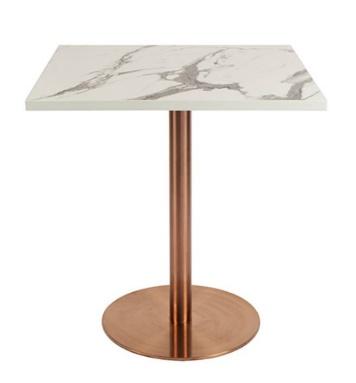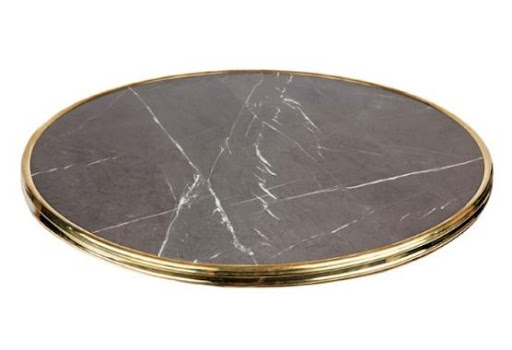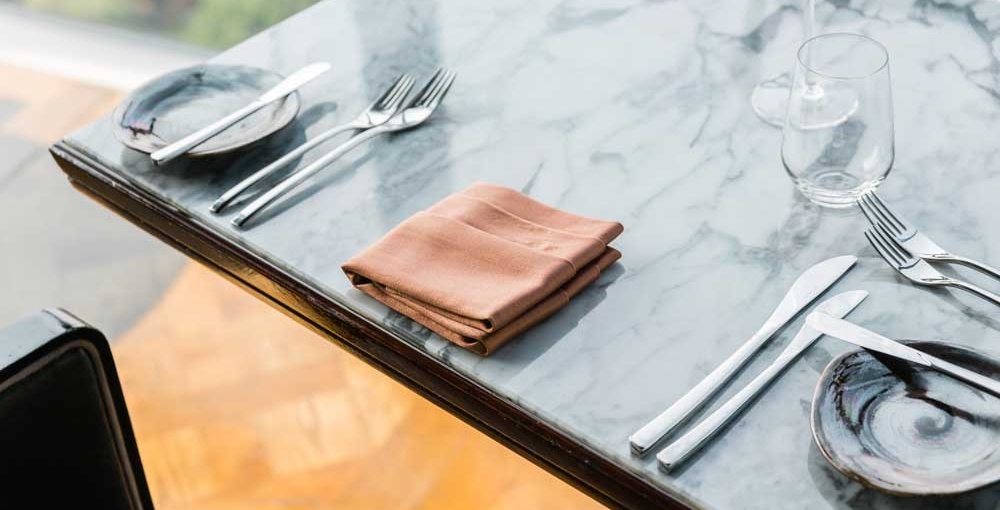Elegant. Classy. Timeless. No, we’re not talking about Nicole Kidman (though the adjectives certainly apply). We’re talking about the appeal of marble tabletops within the restaurant industry. Marble has been having a moment of late. You’ll see it used for flooring, on walls, and as luxurious tabletops. But purchasing marble tabletops is a costly investment, and you might be wondering if that is money worth spending.
So, as one of Sydney’s top sources of hospitality furniture, we’ve decided to offer a crash course we’re calling Marble 101. We’ll break down what it is, the pros, cons, and maintenance of the material, and we’ll offer some more finance-friendly alternatives.
What is marble?
Most marble tabletops found in the restaurant industry are made of Carrera marble. With its light white-grey background and dark charcoal veining, Carrera boasts the classic marble look and can be ordered polished or honed (sanded).
Marble has been used for centuries to convey a sense of class and luxury and is often seen in high-end businesses and private homes.
What are the drawbacks to using marble?
- Marble is one of the most expensive tabletop options available. If you’re budgeting for your first restaurant or looking to renovate your establishment, be prepared for marble tabletops to eat up a significant amount of your budget.
- Marble is a natural stone material, so it should come as no surprise that it is cool to the touch. However, this sensation can be off-putting to some who find that the feel of cold stone detracts from a warm and comforting environment. This isn’t a dealbreaker, but it is something to consider before investing in high-end tabletops.
- Marble is highly porous…which means it is very susceptible to scratches and staining. Coffee rings are often an issue as is surface etching that happens as a result of coming in contact with acidic substances like citrus juices and vinegar. For this reason, many restaurateurs opt for marble tabletops in darker shades to mask the damage.
- If you are going to commit to marble tabletops, you must be prepared for the level of upkeep required…because it is a lot. Spills should be wiped up immediately and stains should be treated with a marble-approved solution. Most marble tabletops made for the hospitality industry come to you with a thin coat of protective sealant applied. Unfortunately, regular use and cleaning naturally wear away at that sealant, so plan to have it reapplied regularly.
- Stones are naturally brittle and marble tabletops are subject to chipping, particularly the corners and edges when tables are pushed together to accommodate larger parties.
- Speaking of moving tables, you must remember that marble is incredibly heavy, so if you are someone who likes to regularly change up the seating arrangement in your space, you may want to opt for lighter tabletops.
What are some cost-effective alternatives to marble?
We’re glad you asked! If you love the look of marble but just can’t get past the price tag, you’ll be happy to know you have options.
- Terrazo – Terrazzo is an inorganic stone material that contains up to 60% of natural quartz. This revolutionary material is eco-friendly, virtually indestructible, and comes in a wide variety of colors.

- Melamine– If you’re looking for a durable tabletop with all the beauty of marble and none of the upkeep, melamine is an excellent choice. This rockstar option boasts a tough outer layer, making it resistant to stains, heat, and moisture. And, since it is made from hardened resin, you don’t have to worry about the chips and scratches that plague genuine marble tabletops.
- Granite – If you want a slightly cheaper natural stone option, granite may be just what you’re looking for. While it is not the cheapest option we’ll mention, it is more budget-friendly than marble and is considered one of the most durable materials for hospitality tabletops.

- Werzalit Resin – Werzalit tabletops are created using a world-renowned, resin-molding process that mixes high-quality hardwood and softwood with resin and anti-rot, anti-mold agents. The result is a long-lasting tabletop that is virtually indistinguishable from genuine marble. We love this moody Werzalit tabletop in stormy grey.
- Corian – This tabletop GOAT has been around since the 1960s…but don’t let that dissuade you. Corian is made by mixing natural minerals with acrylic polymers and can be designed to mimic the veining found in natural marble. It’s also a cost-effective option and easier to maintain thanks to its non-porous surface.

- Laminate – This is a fantastic, budget-friendly option for restauranteurs who love the look of marble but detest the exorbitant price tag. Made by combining high-density fiberboard with plastic and protective resins, laminate offers you plenty of bang for your buck as it is virtually maintenance-free and stain resistant.
- Topalit – This lightweight alternative to marble is made of wood pulp mixed with synthetic resin to create a virtually indestructible tabletop that can withstand high temperatures and exposure to UV light.
No one wants to commit to the upkeep natural marble requires. But here’s the good news—you can find great options out there that mimic the look of this luxurious stone at a fraction of the price…and that’s a win/win in anyone’s book.
Thanks for reading,
Have a Seat
1300 715 937

